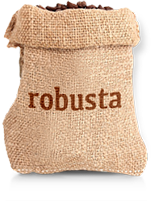O fruto é originário de um arbusto da família das rubiaceae, que se desenvolve em regiões tropicais e equatoriais, entre o Trópico de Câncer e o Trópico de Capricórnio. O seu cultivo é feito entre os 400 e os 2000 metros e está presente na natureza em mais de sessenta espécies, tendo sido batizado com o nome genérico de Coffea pelo naturalista Antoine-Laurent Jussieu.
O fruto do cafeeiro é uma baga designada por cereja do café. Habitualmente existem duas sementes em cada cereja, envolvidas por uma película muito fina designada por pele de prata do café. A diferenciação entre os tipos de café deve-se: à região onde é cultivado, ao solo, ao clima, aos métodos e forma de processamento usados no cultivo.
O Coffea Arábica representa ¾ da produção mundial e é a espécie mais apreciada. Os grãos têm uma tonalidade azul esverdeada e uma forma achatada no corte longitudinal. Caracteriza-se por um gosto suave, aromático e com notas diversas como cacau, especiarias entre outras. Os blends ou lotes considerados de melhor qualidade têm maior presença de arábicas pois estas possuem maior aroma e sabor.
O Coffea Canephora ou robusta é identificado pelos grãos de cor amarelo palha e forma arredondada no corte longitudinal, proporcionam bebidas menos aromáticas e menos ácidas que os arábicas. Destacam-se pelo sabor amargo, corpo e creme abundante. O Coffea canephora, mais conhecida por robusta é uma espécie mais resistente às pragas e às intempéries e vive bem com temperaturas entre os 24°C e os 29°C. É uma espécie que consegue ter mais produtividade, por possuir características mais rústicas.

